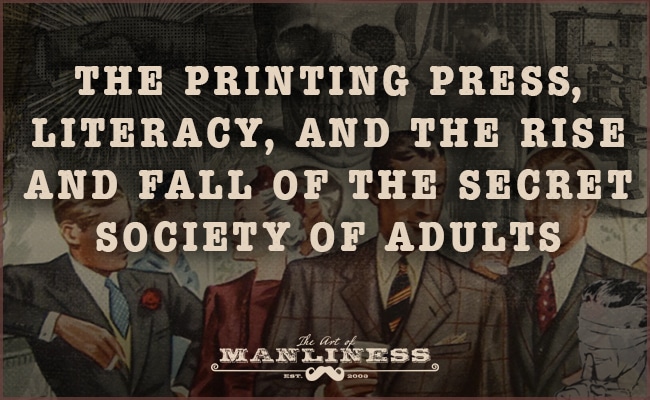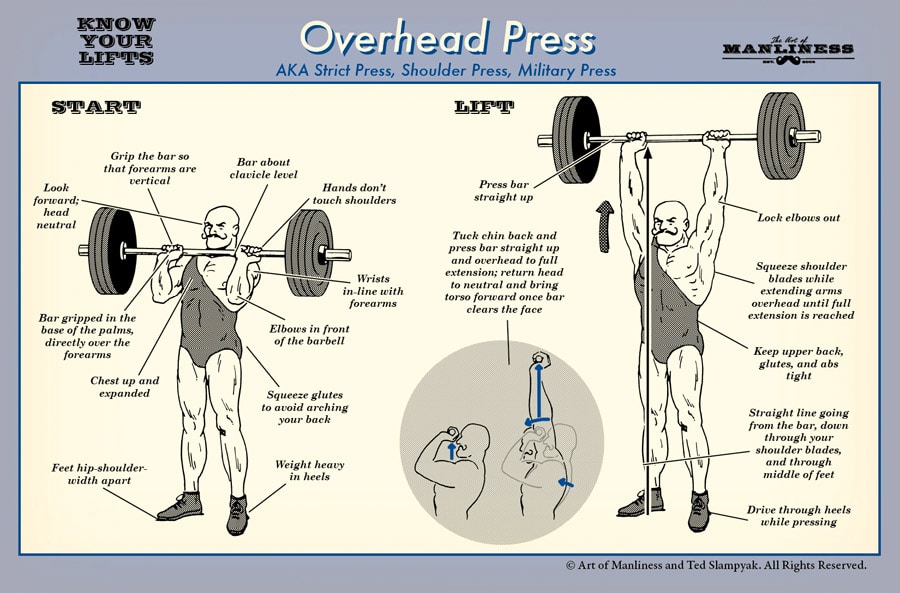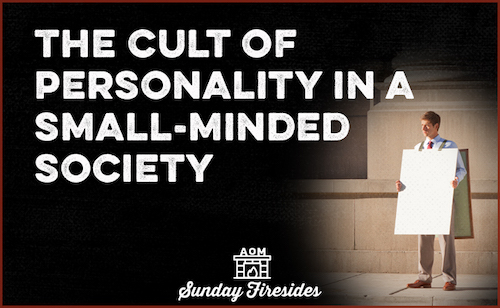
Last week we discussed six reasons the qualities of maturity have been on the decline in the modern age, and made an argument that despite the present difficulty in growing up, the world still needs adults.
In two weeks, we will present a case study on how to become a fully-fledged grown-up without losing your youthful zeal, using the life of Winston Churchill as a guide.
But between these posts, I’d like to submit an interlude of sorts. There is one more factor impeding the attainment of adulthood in the modern world that I considered including in last week’s piece, but decided to leave out, since that article was already so long and people generally have a short attention span (for reasons we’ll delve into today!). But I’d like to explore this theory in its own post, as it is most interesting to consider.
The Printing Press, Literacy, and the Creation of a Secret Society of Adults
As we mentioned last time, the idea that childhood and adulthood represent distinct periods of life is relatively recent in origin. From antiquity through medieval times, a concept of childhood, as we know it today, was almost completely absent in most societies; children were seen as deficient, miniature adults, and were expected to begin to work and take their place in the adult world around the age of 7. Without a real concept of childhood, there was no real concept of adulthood either, as the two states act as foils for each other. Adults and children largely wore the same types of clothes, used the same language, and did the same work. And, in an oral society, the young and the old had access to, and an understanding of, most of the same knowledge. As a result, children in such cultures were rather adult-like, while the adults were somewhat child-like. The young and old were fairly indistinguishable from each other.
In the 15th and 16th centuries, childhood began to be “discovered” as a special time in which little humans are in need of a particular kind of guidance, tenderness, and emotional investment. There are a variety of theories as to why this interest in children arose, but the argument Neil Postman lays out in The Disappearance of Childhood is surely the most fascinating.
Postman argues that our modern concepts of childhood and adulthood (and the gulf between them) were birthed by the printing press. Literacy became the dividing line between these stages of life; adults were competent readers, children were not, and they thus had to become adults by mastering written language.
Typography created a much larger realm of possible knowledge than had ever been possible to learn before. In an oral culture, childhood ended around age 7 because that was the age where kids were able to assimilate most of a society’s store of knowledge. In a literate culture, on the other hand, learning how to comprehend and grapple with a vast library of knowledge took time; a 5-year-old was not ready for the same lessons and texts as a 15-year-old. Thus at the same time that books democratized knowledge, they also added a barrier to entry that had to be steadily surmounted. Step-by-step, and grade-by-grade, the child was initiated into the world of grownups. Boys and girls slowly learned the “secrets” of the adult world by progressively “qualifying for the deeper mysteries of the printed page.”
A critical understanding of the “secrets” of philosophy, faith, nature, sexuality, war, sickness, and death – an “understanding of life’s mysteries, its contradictions, its violence, its tragedies” – is what made an adult an adult, and qualified one for membership in a kind of “society of grownups.” The more degrees of ascending cognitive crafts an adult mastered, the more potential leadership positions were open to him within this fraternity.
Membership in the society of grownups is what granted adults one of their defining qualities: authority. And the desire to seek admission into this fraternity is what helped children develop one of their signature traits: curiosity.
Children were excluded from the society of the literate until they had continually knocked at the door and mastered its traditions and rituals. These qualifications not only included competency with the written word, but the art of self-discipline and civility as well. For Postman argues that literacy didn’t just inculcate the adult ability to think logically and critically, but also beget the qualities necessary for the creation of civilization itself:
“Almost all of the characteristics we associate with adulthood are those that are (and were) either generated or amplified by the requirements of a fully literate culture: the capacity for self-restraint, a tolerance for delayed gratification, a sophisticated ability to think conceptually and sequentially, a preoccupation with both historical continuity and the future, [and] a high valuation of reason and hierarchical order…
As already noted, manners or civilité did not begin to emerge in elaborated forms among the mass of people until after the printing press, in large measure because literacy both demanded and promoted a high degree of self-control and delayed gratification. Manners, one might say, are a social analogue to literacy. Both require a submission of body to mind. Both require a fairly long developmental learning process. Both require intensive adult teaching. As literacy creates a hierarchical intellectual order, manners create a hierarchical social order. Children must earn adulthood by becoming both literate and well-mannered.”
In other words, Postman argues that the printing press helped create a culture of self-restraint and civility, both because these were the qualities necessary to be a good reader, and because they were fitting for a culture that prized literacy. In practicing one’s manners, one practiced the traits necessary for disciplined study, and in studying, one honed the qualities necessary for self-controlled civility. Part of the initiation into the society of adults was learning the “secrets” of social relations, which is why etiquette books proved to be bestsellers for centuries.
To teach children to be “both literate and well-mannered,” schools were created, and this, Postman posits, is what ultimately created distinct cultures of adults and children. Schools separated out children from adults, and each developed their own language, literature (there didn’t used to be such things as “children’s books” or “YA Lit”), clothing, games, and so on. Gradually, children left behind the trappings of kid culture, as they were initiated into the rituals and traditions of adulthood.
A Return to a Pre-literate Society?
Postman observes that our modern society seems to have returned to the conditions that once characterized pre-literate, oral cultures. Adults and children are not so different as they once were; as Postman puts it, “Everywhere one looks, it may be seen that the behavior, language, attitudes, and desires—even the physical appearance—of adults and children are becoming increasingly indistinguishable.”
What has occurred to create this blurring between the different stages of life?
Postman argues that this shift is rooted in the leaving behind of the printed word for a culture that communicates largely through images. Images do not require much in the way of cognitive cultivation to understand them; children and adults can grasp pictures and videos at about the same level. Thus in an image-based society, everyone, of every age, theoretically has access to all of society’s knowledge – all of its “secrets.” No special training is required to grasp them.
The Disappearance of Childhood was published in 1982, and at the time, Postman pointed to the television as the main mover behind the cultural shift away from texts and towards imagery. What he said about TV then, applies equally well, if not more, to the Age of the Internet:
“We may conclude, then, that television erodes the dividing line between childhood and adulthood in three ways, all having to do with its undifferentiated accessibility: first, because it requires no instruction to grasp its form; second, because it does not make complex demands on either mind or behavior; and third, because it does not segregate its audience. With the assistance of other electric, nonprint media, television recreates the conditions of communication that existed in the fourteenth and fifteenth centuries. Biologically we are all equipped to see and interpret images and to hear such language as may be necessary to provide a context for most of these images. The new media environment that is emerging provides everyone, simultaneously, with the same information. Given the conditions I have described, electric media find it impossible to withhold any secrets. Without secrets, of course, there can be no such thing as childhood.”
And, we would add, without secrets there can be no such thing as adulthood either. For if “By definition adulthood means mysteries solved and secrets uncovered,” and “from the start the children know the mysteries and the secrets, how shall we tell them apart from anyone else?”
The internet is highly egalitarian, and websites aren’t generally designated as being designed for certain ages. Adults and children consume much of the same media, surf many of the same sites and forums, and watch the same YouTube videos. It is an age where, as Postman puts it, “everything is for everybody.”
Yet is it really such a bad thing that we move into a society where imagery plays a more prominent role than text? Perhaps it is good that children have access to all the world’s “secrets” at any time — that there is no barrier to any realm of knowledge other than the click of the mouse.
Yet while this open landscape certainly has its benefits, it is not without its downsides:
- When media isn’t distinctly tailored to any age group it ends up getting pitched at about a seventh-grade age level, if that. Everything must be reasonably accessible, entertaining, and most of all, short. People have no patience for in-depth coverage of a subject, feel that anything worthwhile should be able to be summarized in just a few sentences, and believe that anything longer is a waste of time. Which is, of course, exactly what a seventh-grader would say.
- Part of making media and learning palatable to the masses involves turning everything into a narrative – giving everything an entertaining story arc to keep childlike minds interested. “Politics becomes a story; news, a story; commerce and religion, a story. Even science becomes a story.” Of course these issues rarely fit well into neat, black-and-white narratives, and the division of things into good guy, bad guys, and a climax of suspense, simplifies complexity and leaves the facts behind.
- Childlike cognition is very present-minded, and thus news and media is focused almost entirely on the now. Historical context is absent, and looking forward is boring (unless you’re sizing up potential candidates personalities for an election several years hence – now that makes for a great storyline!). Lessons that might be gleaned from the past go undiscovered, and the task of creating critical plans for the future fails to be undertaken.
- Childlike minds also have trouble understanding the varying significance of different events, and the media presents the news so that rendering such a judgment isn’t necessary. Every story seems to bear an equal weight: On the front page of a news website you’ll find stories about war, right next to stories about celebrities’ nude photographs. On television, a sobering report of a school shooting is immediately followed by a cheerful commercial for cheese crackers. Hard-hitting stories are placed on the same level as ads, and every bit of media is framed as equally worthy of attention.
- Media consumers cower before a wall of text, and thus all information must be broken up into bite-sized snacks for the childlike appetite of the masses. That necessitates the breaking up of points into many headings and bullet points – just like these! – for easier digestion. While such devices may make many topics more accessible (which isn’t necessarily a bad thing), there are some (usually important) subjects that cannot be turned into something easily scan-able, and they consequently go unexplored and uninvestigated.
- Ultimately then, while children have access to all knowledge, they receive it without context and before they may be ready to make sense of it. And adults, who have been consuming the very same media, are unable to offer any context either. Thus you have a situation where the knowledge base of both children and adults is highly fragmented, leading to a widespread deficiency in making connections between ideas, and a landscape where myopic, civilization-weakening viewpoints predominate.
The central problem can be summarized this way: in world where “everything is for everybody,” an illusion emerges that “everybody knows everything.” Which is to say, the current media landscape leads one to believe that all knowledge is out there and easily accessible, and that it can, and should be, economically summarized. Yet while breadth of knowledge has decidedly expanded (Eric Schmidt once noted that we create as much information every two days as was created in the whole of human history up to 2003), depth of knowledge has shrunk. Adults no longer acknowledge the hidden expanses lying beneath a subject that might yet be plumbed.
Kids feel the same way, and thus don’t believe that adults have any “secret” knowledge to offer. As a result, the aura of adult authority has been extinguished, and the idea of deferring to one’s elders seems faintly ridiculous.
And, at the same time that the society of grownups has been dissolving, the world of children has been disappearing as well, as Postman explains:
“To a certain extent curiosity comes naturally to the young, but its development depends upon a growing awareness of the power of well-ordered questions to expose secrets. The world of the known and the not yet known is bridged by wonderment. But wonderment happens largely in a situation where the child’s world is separate from the adult world, where children must seek entry, through their questions, into the adult world. As media merge the two worlds, as the tension created by secrets to be unraveled is diminished, the calculus of wonderment changes. Curiosity is replaced by cynicism or, even worse, arrogance. We are left with children who rely not on authoritative adults but on news from nowhere. We are left with children who are given answers to questions they never asked. We are left, in short, without children.”
In a world where “everything is for everybody” and the illusion that “everybody knows everything” prevails, the gap between children and adults evaporates. Everyone besides infants and the very old are “adult-children.” Kids issue know-it-all wisecracks (see: every show on the Disney channel); parents listen to their teenagers’ music and read their kids’ books (see: The Hunger Games). Children dress more like adults, and adults dress more like children. Everybody uses the same language; both grade-school kids and their teachers are likely to spout slang and use profanity. The cultures of grownups and children merge, and this collapse of distance is accelerated by one of the biggest consequences of the dissolution of a literate culture: the unraveling of an emphasis on manners and civility.
No discipline or self-mastery is required to watch and share images and videos, so delayed gratification and well-mannered deportment no longer serve as appropriate ancillaries to the consumption of information as they once did in text-based cultures. In gazing at images, one can shut off their mind and let it all hang out. And that is what adult-children do in their relations with others as well.
Ultimately what these changes have wrought is the disappearance of the desirability of adulthood. Rituals, traditions, and secret knowledge create identity, meaning, and exclusivity and once lent the secret society of adults an aura of mystery. Young people looked forward to the day they could be initiated into this interesting and even glamorous world where people wore special clothes, traded in special knowledge, and used the secret passwords of etiquette to gain access to special parties, dinners, and clubs.
Conclusion
While I find Postman’s theory quite fascinating, I do think it might be too jeremiad-y, even for my curmudgeonly sensibilities. In attributing the complex history of cultural change to a single factor, I feel he ultimately makes the dawn of literacy explain too much. He also does not acknowledge the potential upsides of unlimited accessibility to information (even if that potential is not often utilized). But this may be because he lived in the Age of Television, before the rise of the internet, and there was decidedly less about TV to be bullish about.
Postman’s theory is also not able to completely explain the demise of adulthood, as there were plenty of folks through the centuries (and even today) who were either barely or not at all literate, but were still very mature and adult-like in their outlook on the world and their behavior, including in their manners.
Yet Postman’s perspective does shed some incredibly insightful light on one important prong of the puzzle. Surely the shortness of all our attention spans, the strange pride some feel in dismissing anything overly in-depth as unimportant (as is evidenced by commenters on in-depth articles who note “tl;dr” – meaning “too long, didn’t read” – as a dystopian badge of honor denoting their aversion to reading something that may take more than a minute to digest), the widespread rejection of interest (and even acknowledgment) of deeper mysteries, and the simplistic nature of our news and political debates can only be called childlike.
There is an unfortunate tendency among modern adults to pridefully declare that despite their age, “they don’t know what the f**k they’re doing.” In this way, they can be honest and keep it real, while not feeling bad about continuing to screw up in the very same ways they did when they were fifteen. And it’s true, you think when you grow up you’ll have it all figured out, and then you realize most adults are still struggling to completely get their stuff together too. But every adult should have at least a few areas where their knowledge does run deep, where they’re rightly proud of the wisdom they’ve accumulated from years of study and experience. Every adult should have a treasury of insights that no Google search could ever reveal. When you’re young and confused, bewildered, and freaking out about something, there is truly nothing like coming into the presence of a real adult, partaking of their comforting steadiness and trustworthy gravitas, and walking away with counsel that gives you new insight into life’s big mysteries and simple difficulties. Not only do such interactions help the young along the path of life, they make adulthood seem not so bad after all. Young people need mentors, and they need mentors who make them want to become mentors themselves one day.
At the same time, perhaps a revival in manners and the traditions of adulthood would also offer more to look forward to in growing up. We may see the soirees and etiquette of the past as too formal and too constraining, but they certainly added texture to life. Now we proceed from infancy into adulthood in one flat, unremarkable, unvarying stretch of highway, so that many feel unmoored and bored with life when they are only a quarter-century old.
In restoring the secret society of adults, we might slough off some of the unfortunate cynicism prevalent in both children and grown-ups, rejuvenate the sense of curiosity and wonderment both camps need, impart to the older a more satisfying way of being in the world, and lend the young a worthwhile fraternity to which to aspire.






